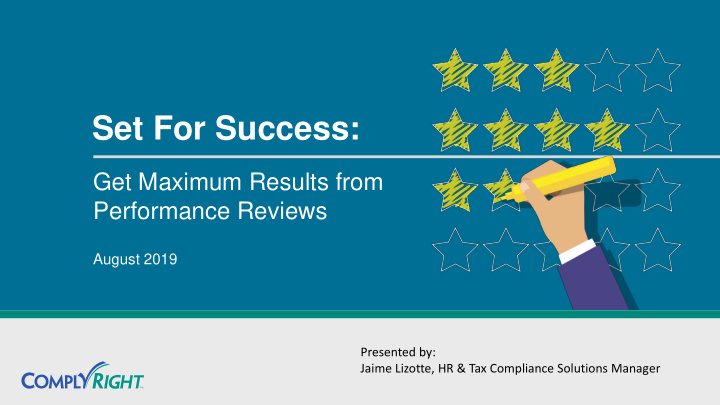



Set For Success: Get Maximum Results from Performance Reviews August 2019 Presented by: Jaime Lizotte, HR & Tax Compliance Solutions Manager
What We’ll Cover How to set meaningful goals to guide employees toward continuous improvement Strategies to correct employee behavior – and protect your business – using progressive discipline What to do if an employee refuses to sign a written warning or review Ways to maximize impact from your performance reviews How to manage employee performance using an effective, affordable online tool
Setting Goals
Setting Goals Establishing goals, or objectives, helps motivate workers Goals should challenge employees while still being attainable Managers need to take goals seriously and use them to evaluate performance on a regular basis Job descriptions can be used as a guide Objectives should be specific and measurable Developmental goals can help workers grow
SMART Goals S pecific: When setting a goal, be specific about what you want to accomplish M easureable: What metrics are you going to use to determine if the goal has been met? A chievable: Can employees realistically meet the goal? R elevant: The goal should makes sense with the broader business goals T imely: A goal should be grounded within a timeframe
SMART Goal Examples “ Respond to marketing research requests by providing the information within one business day .” “Sell $12,000 worth of product each month.” “Create a landing page promoting our new service and have it go live by the end of third quarter .” “Increase demo requests by 15% by year’s end by creating a new product video and case study .” “Increase SEO traffic by 10% in the next two months.”
Documenting Overall Performance
Documenting Performance Document incidents immediately: Don’t wait to write up an issue Be fair and consistent: Treating one employee leniently while coming down hard on another for the same offense can lead to legal trouble Stick to the facts: Describe the who, what, why, where, when and how Record the good and the bad: Document awards, accomplishments, customer feedback, etc.
Documenting Disciplinary Issues
Documenting Disciplinary Issues Stick to the facts: Include the date, time and location of the problem. Be as precise and thorough as possible Focus on the behavior – not the person: Don’t comment on personality traits and don’t include your opinions about the employee Don’t exaggerate: Be careful not to embellish the facts. Avoid using absolutes such as “always” and “never” unless you can substantiate it
Documenting Disciplinary Issues Don’t contradict previous documentation: When describing a performance problem or misconduct, it’s important that your messaging conforms with previous documentation Identify the specific rule or policy violated: Include the rule or performance standard the employee violated in your written warning Indicate expectations for improvement: Communicate what you expect the employee to do to correct the problem. Try to give specific objectives
Documenting Disciplinary Issues Make suggestions for meeting objectives: If applicable, communicate what resources are available to help your employee meet the goals Specify disciplinary action imposed: List the disciplinary action you’re taking as a result of the violation State consequences for failing to correct the problem: Communicate the action you will take if the employee fails to meet the objectives
Using Progressive Discipline
Using Progressive Discipline Progressive discipline puts employees on notice of the problem, allows them the opportunity to correct the behavior, alerts them to the consequences of not improving, and creates a record of the problem. For example, employees may be given: A verbal warning for the first offense A written warning if the problem continues A final written warning And, finally, termination
Using Progressive Discipline To work properly, managers must apply progressive discipline consistently Managers can’t create special rules or allowances for certain people Doing so may be seen as discriminatory by other employees It can destroy morale and lead to a lawsuit
Conducting Reviews
Performance Review Trends Once-a-year evaluations are decreasing Managers today meet with employees regularly regarding performance Appraisals focus more on professional development Employee evaluations aren’t the only criteria for salary increases
Evaluation Types Competency-based review — Ties performance to successful execution of specific, goal- aligned behaviors. It’s a good approach for inexperienced managers Crowd-sourced or 360 review — Uses feedback from coworkers and colleagues to evaluate performance. This can provide more well-rounded input but can also be subjective Employee self-evaluation — Requires the employee to complete a self-assessment in advance of the review meeting. Works best when combined with manager assessment
Review Practices to Avoid Saving all feedback for a once-a-year review. Meaningful performance reviews start with interacting with employees as situations occur Focusing only on recent work. Don’t let near -sightedness result in failing to recognize notable employee achievements from earlier in the year Basing reviews on opinion instead of data. Evaluate your employees based on progress toward stated goals, not subjective standards like personality
Review Practices to Avoid Lumping all employees together. Combined team evaluations don’t address individual strengths and weaknesses Competition creeping into crowdsourcing. If 360 feedback turns into a way for employees to backstab others, you may need to rethink that approach Setting goals too low or high. If you find employees are not challenged to improve, or aren’t meeting expected goals, reevaluate your expectations Not applying standards fairly. Treating employees with similar job roles differently can lead to legal trouble
In the Review Start with praise for work well done Discuss each objective and offer ratings and support your views with examples Invite feedback along the way Point out areas the employee must improve Explain why good performance in certain areas is critical
HR Solutions Manage the entire disciplinary process Treat each violation accurately, promptly, consistently and fairly Link violations together – 3 strikes process Provide Manager’s access to manage their own employees Progressive Discipline Smart App Easy to learn and affordable at $90/year Comes with FREE Employee Records For more information visit www.hrdirectapps.com
Recommend
More recommend